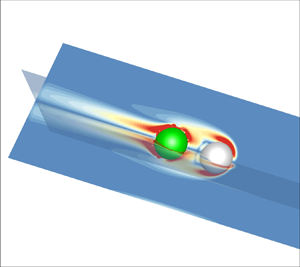Published online by Cambridge University Press: 20 March 2023

We numerically investigate the hydrodynamics of a spherical swimmer carrying a rigid cargo in a Newtonian fluid. This swimmer model, a ‘squirmer’, which is self-propelled by generating tangential surface waves, is simulated by a direct-forcing fictitious domain method (DF-FDM). We consider the effects of swimming Reynolds numbers (Re) (based on the radius and the swimming speed of the squirmers), the assembly models (related to the cargo shapes, the relative distances (ds) and positions between the squirmer and the cargo) on the assembly's locomotion. We find that the ‘pusher-cargo’ (pusher behind the cargo) model swims significantly faster than the remaining three models at the finite Re adopted in this study; the term ‘pusher’ indicates that the object is propelled from the rear, as opposed to ‘puller’, from the front. Both the ‘pusher-cargo’ and ‘cargo-pusher’ (pusher in front of the cargo) assemblies with an oblate cargo swim faster than the corresponding assemblies with a spherical or prolate cargo. In addition, the pusher-cargo model is significantly more efficient than the other models, and a larger ds yields a smaller carrying hydrodynamic efficiency η for the pusher-cargo model, but a greater η for the cargo-pusher model. We also illustrate the assembly swimming stability, finding that the ‘puller-cargo’ (puller behind the cargo) model is stable more than the ‘cargo-puller’ (puller in front of the cargo) model, and the assembly with a larger ds yields more unstable swimming.